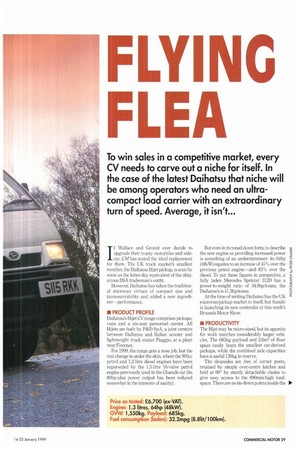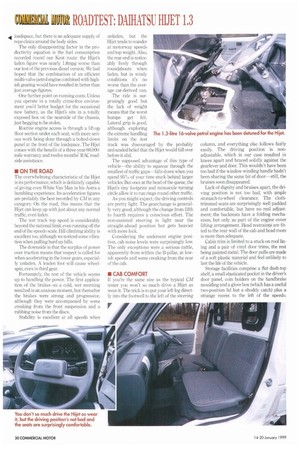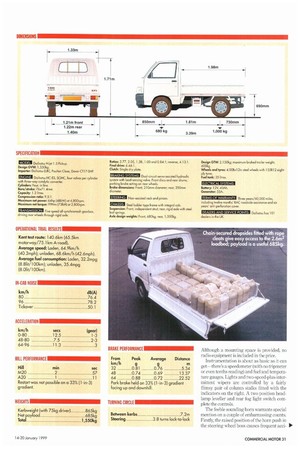FLYING
Page 31

Page 32

Page 33

Page 34

If you've noticed an error in this article please click here to report it so we can fix it.
To win sales in a competitive market, every CV needs to carve out a niche for itself. In the case of the latest Daihatsu that niche will be among operators who need an ultracompact load carrier with an extraordinary turn of speed. Average, it isn't...
If Wallace and Gromit ever decide to upgrade their trusty motorbike and sidecar, Gil9 has tested the ideal replacement for them. The UK truck market's smallest member, the Daihatsu Hijet pickup, is seen by some as the latter-day equivalent of the ubiquitous BSA tradesman's outfit.
However, Daihatsu has taken the traditional microvan virtues of compact size and manoeuvrability and added a new ingredient—performance.
• PRODUCT PROFILE Daihatsu's Hijet CV range comprises pickups, vans and a six-seat personnel carrier. All Hijets are built by P&D SpA, a joint venture between Daihatsu and Italian scooter and lightweight truck maker Piaggio, at a plant near Florence.
For 1999, the range gets a nose job, but the real change is under the skin, where the 993cc petrol and 1.2-litre diesel engines have been superseded by the 1.3-litre 16-valve petrol engine previously used in the Charade car (its 80hp-plus power output has been reduced somewhat in the interests of sanity). But even in its toned-down form, to describe the new engine as providing increased power is something of an understatement: its 64hp (48kW) equates to an increase of 45% over the previous petrol engine—and 83% over the diesel. To put these figures in perspective, a fully laden Mercedes Sprinter 312D has a powento-vveight ratio of 34.9hp/tonne; the Daihatsu's is 41.3hp/tonne.
At the time of writing Daihatsu has the UK microvan/pickup market to itself, but Suzuki is launching its new contender at this week's Brussels Motor Show.
• PRODUCTIVITY
The Hijet may be micro-sized, but its appetite for work matches considerably larger vehicles. The 685kg payload and 2.6m2 of floor space easily beats the smallest car-derived pickups, while the combined axle capacities have a useful 130kg in reserve.
The dropsides are free of corner posts, retained by simple over-centre latches and held at 90° by sturdy detachable chains to give easy access to the 690mm-high loadspace. There are no tie-down points inside the ■
• loadspace, but there is an adequate supply of rope cleats around the body sides.
The only disappointing factor in the productivity equation is the fuel consumption recorded round our Kent route: the Hijet's laden figure was nearly 1.8mpg worse than our test of the previous diesel version. We had hoped that the combination of an efficient multi-valve petrol engine combined with highish gearing would have resulted in better than just average figures.
One further point on running costs. Unless you operate in a totally crime-free environment you'd better budget for the occasional new battery, as the Hijet's sits in a totally exposed box on the nearside of the chassis, just begging to be stolen.
Routine engine access is through a lift-up floor section under each seat, with more serious work being done through a bolted-down panel at the front of the loadspace. The Hijet comes with the benefit of a three-year/60,000mile warranty and twelve months' RAC roadside assistance.
• ON THE ROAD The overwhelming characteristic of the Hijet is its performance, which is definitely capable of giving even White Van Man in his Astra a humbling experience. Its acceleration figures are probably the best recorded by CM in any category. On the mad, this means that the Hijet can keep up with just about any normal traffic, even laden.
The test track top speed is considerably beyond the national limit, even running off the end of the speedo scale. Hill climbing ability is excellent too, although we noticed some vibration when pulling hard up hills.
The downside is that the surplus of power over traction means that respect is called for when accelerating in the lower gears, especially unladen. A leaden foot will cause wheelspin, even in third gear.
Fortunately, the rest of the vehicle seems up to handling the power. The first application of the brakes on a cold, wet morning resulted in an anxious moment, but thereafter the brakes were strong and progressive, although they were accompanied by some creaking from the front suspension and a rubbing noise from the discs.
Stability is excellent at all speeds when unladen, but the Hijet tends to wander at motorway speeds and top weight. Also, the rear end is noticeably lively through roundabouts when laden, but in windy conditions it's no worse than the average car-derived van.
The ride is surprisingly good but the lack of weight means that the worst bumps get felt. Lateral grip is good, although exploring the extreme handling limits on the test track was discouraged by the probably unfounded belief that the Hijet would fall over before it slid.
The supposed advantage of this type of vehicle—the ability to squeeze through the smallest of traffic gaps—falls down when you spend 95% of your time stuck behind larger vehicles. But once at the head of the queue, the Hijet's tiny footprint and minuscule turning circle allow it to run rings round other traffic.
As you might expect, the driving controls are pretty light. The gearchange is generally very good, although the change from fifth to fourth requires a conscious effort. The non-assisted steering is light near the straight-ahead position but gets heavier with more lock.
Considering the underseat engine position, cab noise levels were surprisingly low. The only exceptions were a serious rattle, apparently from within the [3-pillar, at lowish speeds and some creaking from the rear of the cab.
• CAB COMFORT
If you're the same size as the typical CM tester you won't so much drive a Hijet as wear it. The trick is to put your left leg directly into the footwell to the left of the steering column, and everything else follows fairly easily. The driving position is nonadjustable, which in our case resulted in knees apart and braced solidly against the gearlever and door. This wouldn't have been too bad if the window winding handle hadn't been sharing the same bit of door—still, the bruises soon disappeared.
Lack of dignity and bruises apart, the driving position is not too bad, with ample stomach-to-wheel clearance. The clothtrimmed seats are surprisingly well padded and comfortable, but have no real adjustment; the backrests have a folding mechanism, but only as part of the engine cover lifting arrangement. Head restraints are fitted to the rear wall of the cab and head room is more than adequate.
Cabin trim is limited to a stuck-on roof lining and a pair of vinyl door trims, the rest being painted metal. The door pulls are made of a soft plastic material and feel unlikely to last the life of the vehicle.
Storage facilities comprise a flat dash-top shelf, a small elasticated pocket lathe driver's door panel, coin holders on the handbrake moulding and a glove box (which has a useful two-position lid but a shoddy catch) plus a strange recess to the left of the speedo.
Although a mounting space is pnwided, no radio equipment is included in the price.
Instrumentation is about as basic as it can get-there's a speedometer (with no tripmeter or even tenths reading) and fuel and temperature gauges. Lights and two-speed-plus-intermittent wipers are controlled by a fairly flimsy pair of column stalks fitted with the indicators on the right. A two position headlamp leveller and rear fog light switch complete the controls.
The feeble sounding horn warrants special mention on a couple of emban-assing counts. Firstly, the raised position of the horn push in the steering wheel boss causes frequent acciOP• 41 dental operation by twirling forearms, and on one occasion the horn switch stuck on in the middle of town.
Except for a major blind spot over the driver's right shoulder visibility is excellent; the powerful halogen headlamps and reflectionfree windscreen help night driving. The narrowness of the Hijet's cab means that the passenger door mirror is adjustable from the driving seat (when stationary, of course).
The heating system is certainly effective, warming up rapidly and producing lots of heat. The picture's not quite so good when it comes to cooling the cabin. There's plenty of cold air available through the fresh air vents, but it's accompanied by a continuous bleed of warm air through the heater vents, even with the temperature slide at its lowest position. The heater controls themselves are rather unpleasant, needing considerably varying forces in different directions.
The perceived passive safety of the Hijet type of vehicle is still open to question-the light construction of the forward-control cab means that the driver is forever conscious of the implications of a frontal impact, and never more so than in a vehicle capable of the best part of 100mph. Airbags are from another world; your only hope is to grow your own crumple zones.
• SUMMARY While many aspects of the Hijet 1.3, including outstanding productivity and performance, are extremely impres
sive, there remains a significant question mark over build quality. Among the problems we experienced were that sticking horn push, loose wiper spindles, excessive play in the steering column top bush, a faulty heater, rattling B-pillar and rust on the nuts holding the seat to the engine cover.
Individually any one of these faults could be put down to an unfortunate oversight, but so many on one new vehicle seems to indicate a more fundamental quality-control problem. Maybe this is down to the traditionally temperamental Italian workforce sulking at not being allowed to make Ferraris. Fortunately, whatever the cause, that generous warranty should allow delivery faults to be sorted out in time.
Despite its micro-size the Hijet is not quite the cheapest load carrier on the market, and we are left feeling that you would really have to need something this compact to buy it in preference to a Skoda Felicia.
But if you do need to carry a decent load through confined spaces in a hurry, the Hijet 1.3 is for you. Unfortunately for our animated window cleaning friends, it can't actually fly-they'll just to have to wait for the next version with the twin-turbo V12.
E by Colin Barnett








































































































